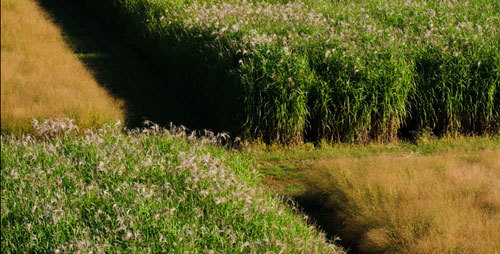10-year trials show 10-ton yields for miscanthus in Illinois




University of Illinois, L. Brain Stauffer
December 26, 2013
BY Sue Retka Schill
Illinois researchers reported results from a decade of field trials with miscanthus, the first plots to be planted in the U.S. The average annual yield of miscanthus grown in seven Illinois locations over a period of eight to 10 years was 10.5 tons per acre, compared with 4.5 tons per acres for switchgrass grown in the side-by-side trials.
“If cellulosic comes on stream, these yields would be competitive with corn on poor land,” said Stephen Long, University of Illinois plant biology and Institute for Genomic Biology professor. To illustrate, he pointed out that when northern Illinois farmers get 200 bushel corn, southern Illinois farmers on less productive soils often see less than 100 bushel corn. With reported prices for miscanthus pellets bound for Europe at $100 per ton, a 10 ton per acre yield of the tall perennial grass would be competitive with even high-priced corn.
Advertisement
Advertisement
Farmers are also showing interest in the prospect of growing a perennial crop that both yields almost as well on poor soils as fertile soils and builds organic soil matter. “After five years, the roots and rhizomes contribute 12 tons per acre to the soil, and that’s dry mass,” Long said. The extensive root system also makes it a good choice for stabilizing sloped or erodible soils. Another advantage is the crop can be grown with little or no added fertilizer, and research has established that while there is a response to added nitrogen, it is small compared to fertilizing crops like corn, and thus probably not large enough to justify the cost of fertilizer.
Long recently reported the findings in the journal Global Change Biology: Bionenergy. Long and his colleagues calculated the total land area needed to produce enough miscanthus to meet the renewable fuel standard mandate for cellulosic ethanol production by the year 2022, finding that the targeted 16 billion-gallon cellulosic volume. would require 17 million acres of Miscanthus x giganteus or 39 million acres of switchgrass. “That 39 million acres sounds like a lot and is a lot, but keep in mind that the 48 contiguous states are almost 2,000 million acres,” Long said. “We use only about a fifth of that in our row-crop agriculture – cotton, corn, soybean, wheat, etc. And we actually have at least 550 million acres that have been abandoned from agriculture in the last 150 years. This is not land that has been lost to urban sprawl.”
Advertisement
Advertisement
The research at the University of Illinois that started with Long and a single graduate student has now grown to 10 faculty members looking at different aspects of the crop, he reports. In his research, he has begun examining the mechanisms in miscanthus that allows the plant to begin growing earlier and later in the season than related crops, such as corn. “And, can we transfer that to related crops? We could perhaps create a more cold tolerant sorghum, for example,” he added.
Related Stories
The U.S. Department of Energy Bioenergy Technologies Office (BETO) announced up to $23 million in funding to support research and development (R&D) of domestic chemicals and fuels from biomass and waste resources.
The U.S. DOE has announced its intent to issue funding to support high-impact research and development (R&D) projects in two priority areas: sustainable propane and renewable chemicals and algal system cultivation and preprocessing.
Sens. Sherrod Brown, D-Ohio, and Pete Ricketts, R-Neb., in August introduced the Renewable Chemicals Act, a bill that aims to create a tax credit to support the production of biobased chemicals.
The Chemical Catalysis for Bioenergy Consortium, a consortium of the U.S. DOE’s Bioenergy Technologies Office, has launched an effort that aims to gather community input on the development of new biomass processing facilities.
USDA on March 8 celebrated the second annual National Biobased Products Day, a celebration to raise public awareness of biobased products, their benefits and their contributions to the U.S. economy and rural communities.
Upcoming Events










